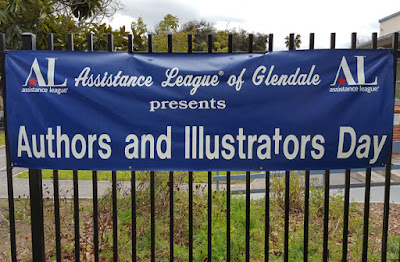 |
| Six authors visiting Balboa Elementary School, Glendale, CA |
Last Wednesday I was one of six authors visiting classrooms at Balboa Elementary School in Glendale, California. The day was sponsored and organized by the wonderful hard working volunteers of the Glendale Assistance League, a service organization that arranges four such events in the Glendale schools every year. My fellow authors at Balboa were Carter Higgins, Tim Egan, Alexis O’Neill, Oliver Chin, and Julie Berry, each of us assigned to a different grade.
I spoke to students in kindergarten, going to four classrooms during the day. During my visit with the children we talked about what authors and illustrators do and how I get my ideas. I asked the children in each class to tell me their favorite animals and I got a wide variety of answers ranging from spiders and crocodiles to lions and gorillas. I shared
Hatching Chicks in Room 6 and we also talked about other kinds of birds. I showed them my feather collection and I measured their wingspans. I also read part of my book
Wiggle and Waggle and we all sang the Wiggle and Waggle song together. At the end of the day I joined all of the authors in the auditorium for the book sale and signing. It was a most enjoyable day!
 |
| With my author sign at the after school book signing |
I thank all the members of the Glendale Assistance League that make this program possible for the children of Glendale. I especially thank Linelle Vincenti for organizing the schedule of the day, all the volunteers who guided us around the school, helped with the book sale, and provided a delicious lunch, as well as our special student council representatives who took us to our classrooms. I also thank Maureen Palacios of Once Upon a Time bookstore in Glendale, for providing the books for the book sale.
I do many author days, but usually speak to large groups of children. It was a treat to be in the classroom with smaller groups and have the opportunity for a more personal interaction with the children. Thank you Glendale Assistance League for a wonderful Authors and Illustrators Day.
 |
| Balboa Elementary School, Glendale, CA |












